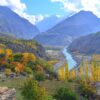Pakistan’s Hunza Valley: A Tale of Adventure, Culture and Breathtaking Views
Pakistan’s Hunza Valley lies at the intersection of the Hindu Kush, Himalaya, and Karakoram mountain ranges. Along side with the roaring Indus and Gilgit Rivers. Visit Hunza valley to witness one of the world’s most thrilling drives up the famed Karakoram Highway and into Pakistan’s remote Northern Areas, then wend your way down through some of the rawest mountain scenery imaginable.
From relatively modern Islamabad, trace an ancient artery of the Silk Road, traveling on the Karakoram Highway. Climb into the old kingdom of Hunza, pausing to explore the remnants of past empires, soak in splendid views, and meet the region’s welcoming Ismaili people.
HUNZA VALLEY: THE MOST EXOTIC TERRAIN IN THE WORLD
A valley situated in the extreme North of Pakistan often referred to as “heaven on Earth”, Hunza is one of the most beautiful valleys in the world. This lush green valley has an abundance of mountains, glaciers, natural beauty, and exceptionally rich culture. The history of Hunza commences around 2000 BC when it was first tenanted by humans.
The rock carvings in Passu serve as proof of this. There’re many similar carvings throughout Gilgit-Baltistan. It’s known that the first settlers in Hunza Valley were not the Dardic people but Tibetans. Currently, the region has various surviving Buddhist archaeological sites, famously known as the sacred Rock of Hunza.
This region was a significant trade route from Central Asia to the Subcontinent. Primitively, it said that the Hunza Valley provide shelter to Buddhist missionaries and monks visiting the subcontinent, also the region played an important role in the spread of Buddhism throughout Asia. Earlier, Hunza was a princely state bordering Xinjiang to the Northeast and Pamir to the northwest.
In 1891 Hunza was occupied by British Empire, and the ruler of Hunza, Mir Safdar Ali Khan, fled to Kashgar, China the British army installed his brother Mir Nazim Khan as a puppet ruler of Hunza Valley, but all orders were mainly passed by British officers who were stationed in the Capital Gilgit. The Princely State was dissolved during the administration of Zulfiqar Ali Bhutto in 1974 with the help of some brave locals.
Geographically, Hunza Valley entails three regions: Gojal (upper Hunza), Central Hunza, and Lower Hunza (Shinaki). The Hunza Valley is situated in the Northern part of the Gilgit-Baltistan region of Pakistan. Hunza Valley borders Ishkoman to the northwest, Shigar to the southeast, Afghanistan’s Wakhan Corridor to the north, and the Xinjiang region of China to the northeast. The Hunza Valley surface is at an altitude of 2,438 meters (7,999 feet).
Book a tour to Hunza Valley and see it by yourself.
The Various Peaks of Hunza Valley
Numerous high acme’s rise above 7,000 m in the environs of Hunza Valley. Rakaposhi 7,788 m (25,551 ft), Ultar Sar 7,388 m (24,239 ft), Bojahagur Duanasir II 7,329 m (24,045 ft), Diran peak (7,266), Spantik (7027m), Ghenta Peak 7,090 m (15,631 ft), Hunza Peak 6,270 m (20,571 ft), Darmyani Peak 6,090 m (19,980 ft), and Bublimating (Ladyfinger Peak) 6,000 m (19,685 ft).
Many 7,000 m mountains are present in Hunza like Distaghil Sar, Batura, Batura II, Batura III, Muchu Chhish, Kunyang Chhish, shispare, Passu Sar, Kanjut Sar, Yukshin Gardan Sar, Pumari Chhish, Momhil Sar and many more. This valley is situated up in the north close to the border of China in the Karakoram Ranges, one of the highest ranges of mountains in the world.
Hunza Valley is one of the top loved location by couples, check out this amazing honeymoon tour to Hunza Valley.
People of Hunza Valley
The indigenous people of this region are benevolent and hospitable people. The natives will invite the tourists to stay with them and experience their culture, they will share their food, fruit, and their homes without expecting anything back in return. The people of Hunza are deferential, courteous, and tolerant. The polite and welcoming nature of the people of Hunza makes the sightseeing and mountaineering expeditions of the tourists two times better.
Hunza Valley’s Culture
The people of Hunza carry their culture with them wherever they go and this is one of their strongest points. Almost every aspect of their life is influenced by their strong cultural values and traditions. You can see these cultural values being reflected in their art, architecture, music, lifestyle, food, dressing, and traditions like marriage, death, and religion.
The Hunzai culture is one of the most intriguing cultures in the world because it influences almost every single aspect of an individual’s life. Three languages are spoken in Hunza which are known as Burushashki, Wakhi, and Shina. The majority of the people speak Burushashki followed by Wakhi and then shina.






